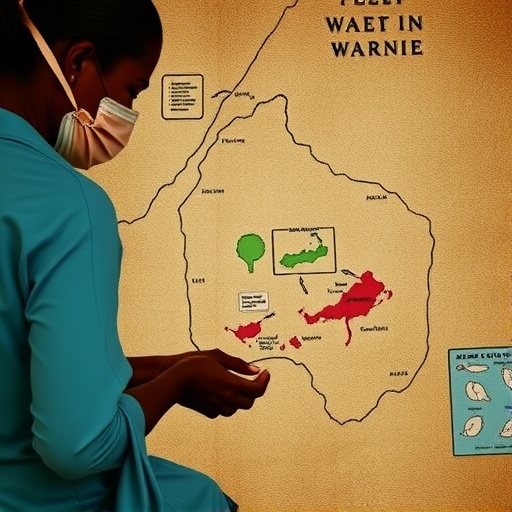A groundbreaking study conducted by researchers from Lancaster Medical School, in collaboration with the University of Naples Federico II and the World Health Organization Collaborating Centre for the Diagnosis of Intestinal Helminths and Protozoa, has unveiled novel statistical modelling techniques to enhance the detection of neglected tropical diseases (NTDs) among migrant populations. Published in the esteemed journal PLOS Neglected Tropical Diseases, this research uniquely integrates country-level epidemiological indicators with individual demographic data to sharpen the predictive accuracy for soil-transmitted helminth (STH) infections, particularly in a migratory context.
Neglected tropical diseases, a group consisting of 21 parasitic and bacterial infections, predominantly affect impoverished populations in tropical and subtropical regions. These diseases impose debilitating health burdens, often perpetuating cycles of poverty due to their chronic and disabling nature. As global migration flows continue to diversify, the risk profile for NTDs shifts, presenting new challenges for healthcare systems in destination countries unaccustomed to endemic tropical infections. Early and precise identification of infected individuals plays a crucial role in interrupting transmission and improving treatment outcomes.
The focal point of this study was soil-transmitted helminths, a category of intestinal parasitic worms that includes Ascaris lumbricoides, various species of hookworms, and Trichuris trichiura. These helminths infect over a billion people worldwide, causing malnutrition, impaired cognitive development, and increased morbidity. The researchers utilized a dataset comprising 3,830 migrants arriving in Italy’s Campania region from 64 countries, predominantly male with a median age of 27, to develop and validate models that integrate multilevel variables for infection risk prediction.
Unlike traditional diagnostic approaches relying solely on laboratory tests or clinical screening, the study proposed a hybrid modelling strategy harnessing both micro-level variables—such as age, sex, and individual clinical records—and macro-level country indicators reflecting the epidemiological landscape of migrants’ countries of origin. Publicly available datasets capturing regional disease prevalence, sanitation infrastructure, and socioeconomic factors were incorporated as country-level predictors to enrich the contextual understanding of infection risk.
Within this framework, various statistical models were trained and compared to predict the prevalence of STH infections among migrants from both previously observed and entirely new countries. The results revealed that models incorporating combined individual and country-level data significantly outperformed those relying on individual variables alone. Specifically, the country of origin emerged as a stronger predictor for A. lumbricoides infections and overall STH presence, underscoring the epidemiologic imprint of endemic regions on migrant health profiles.
Among African countries, Guinea Bissau demonstrated the highest prevalence of soil-transmitted helminth infections, with approximately 25% of migrants from this nation testing positive for STH. In the context of South-East Asia, Bangladesh stood out with an 18.6% prevalence rate among its migrant population. These findings point to the necessity of tailoring screening protocols to the nuanced infection profiles associated with migrants’ countries of origin, leveraging data-driven stratification to optimize resource allocation and clinical workflow.
Lead PhD researcher Jana Purkiss emphasized the practical implications of this data-centric approach. She articulated that the integration of statistical models with accessible epidemiological data offers a scalable, objective means to enhance early diagnosis and enable targeted screenings. This method not only facilitates more judicious use of specialist parasitology laboratories but also mitigates the risk of missed infections, thereby improving public health outcomes and reducing the hidden burden of neglected tropical diseases in non-endemic settings.
The study’s methodology involved rigorous multivariate analysis and validation techniques to ensure robustness across demographic heterogeneity. Innovative algorithms were tailored to accommodate data sparsity inherent in migrants from less represented countries, providing a generalizable framework for predicting parasitic infections even in under-sampled populations. This addresses a critical gap in existing epidemiological models that often falter when extrapolating beyond well-studied cohorts.
Importantly, the research also highlighted limitations, such as the comparatively lower predictive performance for Trichuris trichiura infections. Experts suggest this may be due to complex biological and environmental variables that are not fully captured by current country-level indicators, pointing to a direction for future refinement of modelling approaches. Collaborative efforts between epidemiologists, biostatisticians, and public health authorities are poised to build upon this foundation to develop more comprehensive risk stratification tools.
In recognition of its innovative contribution, the paper garnered attention in a PLOS NTD viewpoint article, where specialists praised the integration of data streams and offered recommendations for enhancing model sensitivity and specificity. These include incorporating individual behavioral factors and advanced genomic data to further delineate infection risk profiles, thereby amplifying the predictive granularity of the approach.
Looking ahead, the multidisciplinary research team aims to expand their work through transnational partnerships, integrating data from border health clinics and leveraging machine learning techniques to adaptively update models as epidemiological trends evolve. Such dynamic frameworks have the potential to revolutionize parasitic disease surveillance in migrant-receiving countries, fortifying global health security amidst increasing population mobility.
This study not only underscores the power of combining epidemiological intelligence with personalized screening data but also represents a transformative stride toward data-driven public health interventions. By harnessing sophisticated statistical tools, healthcare systems can better anticipate infection risks, allocate screening resources more efficiently, and ultimately diminish the burden of neglected tropical diseases in migrant populations worldwide.
Subject of Research: Not applicable
Article Title: Combining country indicators and individual variables to predict soil-transmitted helminth infections among migrant populations: A case study from southern Italy
News Publication Date: 13-Jun-2025
Web References: 10.1371/journal.pntd.0012577
Image Credits: Lancaster University
Keywords: Neglected Tropical Diseases, Soil-Transmitted Helminths, Statistical Modelling, Migrant Health, Epidemiology, Public Health, Predictive Modelling, Parasitic Infections, Data-driven Screening, Infectious Disease Surveillance




